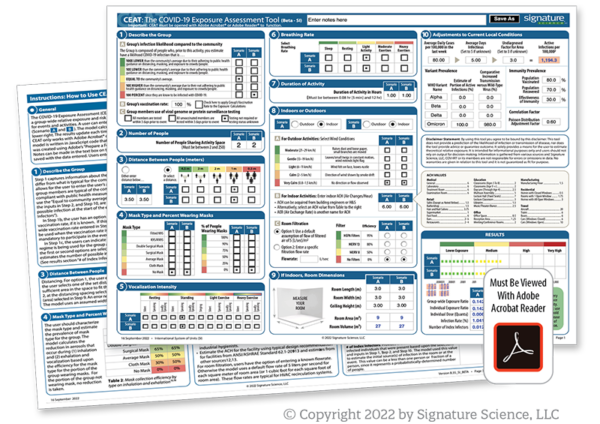COV-IRT Member Signature Science LLC Releases Update to its SARS-CoV-2 Exposure Assessment Tool, CEAT
 This simple-to-use tool, released as a Beta version, allows users to estimate a group-wide relative exposure to SARS-COV-2 associated with various activities. The tool facilitates understanding of the relative importance of factors that contribute to increased exposure. It incorporates both scientific principals and recent findings regarding virus characteristics to assess relative exposure based on the key mechanistic and epidemiological factors.
This simple-to-use tool, released as a Beta version, allows users to estimate a group-wide relative exposure to SARS-COV-2 associated with various activities. The tool facilitates understanding of the relative importance of factors that contribute to increased exposure. It incorporates both scientific principals and recent findings regarding virus characteristics to assess relative exposure based on the key mechanistic and epidemiological factors.
Factors Assessed by Tool
1) the emission rate of virus, 2) viral aerosol degradation and removal, 3) duration of activity/exposure, 4) inhalation rates, 5) ventilation rates (indoors and outdoors), 6) volume of indoor space, 7) HVAC filtration removal efficiency, 8) mask use and effectiveness, 9) distance between people, 10) group population’s adherence to public health guidance, 11) size of the group, and 12) prevalence of infection (including variants) and immunity in the population. The nomogram model can be broadly applied to many situations (i.e., worker safety, public events, and schools). The model’s results are aligned with the United States Occupational Safety and Health Administration (US OSHA) classifications of exposure risks, by benchmarking the exposure calculations to a baseline scenario that is considered high risk by US OSHA. We define the baseline scenario to represent a person (i.e., medical worker) who is exposed in close proximity to a COVID-19 infected person.
Estimating the Relative Concentration of Aerosols that May Contain Virus
One critical variable that is estimated by the model is the concentration of virus-containing aerosols that occurs as a result of the exhalation (i.e., breathing and singing) from people in close proximity. The underlying concentration model used in the tool assesses both the contributions of concentration of virus due to the “nearness” of people (i.e., people in the Near Field whether indoors or outdoors) and the build-up of concentration in a room over time (Far Field – only used indoors). These concentration contributions are calculated for a person assumed to be at the center of a triangular grid where people are spaced equidistantly (based upon the distancing specified). We assume the concentration at the center is representative for all people in the group since: (1) each person’s location is likely not static during the activity and (2) exposure is driven chiefly by the close-in sources (i.e., other people) and all people have close-in sources. The exposure calculation also incorporates the likelihood that people in the group are infected based on the prevalence of infection in the local community and assumed adherence to public health guidance, as well as the air changes per hour associated with the venue, the assumed activity level of individuals (affecting inhalation and exhalation rates) and the duration of the event.
An Example of the Exposure Assessment Tool in Use
GATHERINGS

